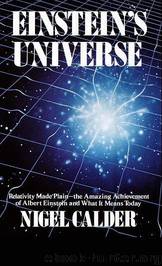Einstein's Universe by Nigel Calder

Author:Nigel Calder
Language: eng
Format: mobi, epub
Tags: Special Relativity, Universe, General Relativity, Gravity, Speed of Light, Astronomy, Physics
ISBN: 0517385708
Publisher: Gramercy
Published: 1988-11-01T20:30:00+00:00
* * *
12: The Galileo Mystery
The effects of gravity and acceleration are equivalent.
Everything must fall at the same rate.
light bends in an accelerating spaceship.
An accelerating spaceship could create a black hole behind it.
The Moon's motion confirms Einstein's 'equivalence principle'.
Falling is the most natural way for objects to behave and our main mode of travel through the universe, aboard our planet. Nevertheless in relation to the Earth itself we spend most of our time not falling. There is not really a black hole at the centre of the Earth, although apples and landslides and the man who slips on a banana skin try to move towards the centre just as if it were there. They find firm ground barring their way. The atoms of our planet are comfortingly strong compared with the effect of gravity and they build rigid rocks for us to stand on. 'Not-falling' appears in Einstein's theory of gravity as an acceleration - a continual gathering of speed - even when you are staying in one place.
A helicopter offers a clue to this interpretation. It has to keep its engine working frantically to avoid falling. The pilot and his passengers feel their seats pushing upwards even when the helicopter is plainly just hovering at one place. But they are perfectly comfortable, because that is exactly what they feel if they are sitting on the ground. If the helicopter now climbs quickly, the seats push harder on the people. They seem heavier and they feel their stomachs tending to be left behind. The push upwards is often called a '^-force'. In free fall it is zero 'g'. On the Earth's surface or in the hovering helicopter it is oneg . In a spaceship being blasted into space it is several # and g-forces are, for a while, very strong and unpleasant.
Now imagine an astronaut in a very fast spaceship, coming home after a long trip but with plenty of power to spare. He has to lose a lot of speed before he reaches the Earth, which means that he must swivel his ship around and fire his rockets forward, for a long time, to act as a brake. To be comfortable, he adjusts the rockets so that the#-force is oneg. He then stands or sits with his feet pointing in the direction of travel and feels exactly the same as he would feel on the Earth. Satisfied that his computer has the flight-plan perfectly set, he puts shutters over all windows so that there is no risk of them melting in the friction of the Earth's atmosphere.
His friends and relations come to the spaceport to meet the astronaut. They see the ship come smoothly down, losing speed all the time. It approaches to within six inches of the ground and stops. Its motors are still blasting away, so the friends and relations dare not approach. They wait for the astronaut to switch off the motors and come out. But the astronaut is reading a book. With his windows sealed he is completely unaware that he has arrived home.
Download
This site does not store any files on its server. We only index and link to content provided by other sites. Please contact the content providers to delete copyright contents if any and email us, we'll remove relevant links or contents immediately.
The Complete Stick Figure Physics Tutorials by Allen Sarah(7307)
Secrets of Antigravity Propulsion: Tesla, UFOs, and Classified Aerospace Technology by Ph.D. Paul A. Laviolette(5309)
Thing Explainer by Randall Munroe(3875)
The River of Consciousness by Oliver Sacks(3535)
The Order of Time by Carlo Rovelli(3144)
How To by Randall Munroe(3031)
A Brief History of Time by Stephen Hawking(2959)
I Live in the Future & Here's How It Works by Nick Bilton(2934)
The Great Unknown by Marcus du Sautoy(2645)
What If?: Serious Scientific Answers to Absurd Hypothetical Questions by Randall Munroe(2637)
Midnight in Chernobyl by Adam Higginbotham(2483)
Blockchain: Ultimate Step By Step Guide To Understanding Blockchain Technology, Bitcoin Creation, and the future of Money (Novice to Expert) by Keizer Söze(2444)
Networks: An Introduction by Newman Mark(2358)
The Meaning of it All by Richard Feynman(2298)
Easy Electronics by Charles Platt(2281)
The Tao of Physics by Fritjof Capra(2227)
Midnight in Chernobyl: The Untold Story of the World's Greatest Nuclear Disaster by Adam Higginbotham(2176)
When by Daniel H Pink(2082)
Introducing Relativity by Bruce Bassett(2076)
